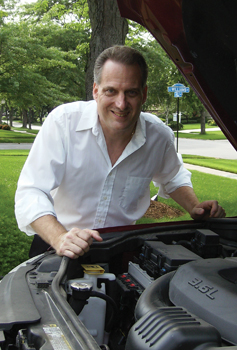 By Carl Fedele
By Carl Fedele
Automotive instructor
“My car seems a bit sluggish.”
“My car seems to consume too much fuel lately and I do not understand why. I just had a tune-up about a month ago and the technician said everything was good to go.”
“I always go to the same gas station for fuel. Could I have received a bad tank of fuel?”
“At times I notice a ‘check engine light’
flashing on my dashboard, but it hasn’t come on for a while. Is something wrong?”
“Will a tune-up fix my ‘check engine light’ problem?”
How many times has a technicians heard these lines from customers? Plenty, I would say.
In fact, I have heard these and several others closely related to them for a very long time from customers, both in the field and in the classroom. I’ve also heard them as a technical advisor. The first question that I ask when responding is, “how many miles are on the engine?”
Of course, basic questions on the year, make and model of the vehicle also should be asked. Next, I usually try to find out if the “check engine light” comes on and off while driving in certain situations. For example, does it occur while driving over 40 mph or while driving slower, and does it happen when idling at a stoplight?
A lot of people are assuming that when the check engine light comes on they need to tune-up their cars. On today’s automobiles, a so-called tune-up is just replacing spark plugs and filters. But, very few technicians think of replacing the oxygen sensor when replacing the plugs. Even if auto manufactures don’t suggest changing spark plugs till 100,000 miles, there is a preventive maintenance procedure involving the replacement of the oxygen sensor at certain mileage intervals.
I know what you’re thinking, most all cars today have more than two oxygen sensors and replacement is going to cost quite a bit. Most customers do not understand what these sensors do and therefore would not go for changing them until they go bad. But, as they are wearing, they cause numerous problems with the driveability system and will affect quite a number of problems, therefore increasing the cost of the repair down the road. Most of today’s oxygen sensors are heated, so the computer system will go into closed loop faster, thereby saving on fuel mileage and performance.
To achieve good fuel mileage and performance, the correct mix of fuel and air must be burnt within the engine. That ratio is known as the stoichiometric ratio (14.7:1), and represents the ideal mix of air-to-fuel mass. The engine computer, better known as the ECM or PCM, uses the information it receives from the oxygen sensors to make sure the fuel charge is correct. After receiving this information, the ECM will trim the pulse width on the fuel injectors.
The amount of fuel trim required is determined by the ECM’s monitoring of the residual oxygen in the exhaust stream before it gets to the catalytic converter using the oxygen sensor. A more accurate name is the lambda sensor, and its job is to tell the ECM whether the residual oxygen in the exhaust stream is a result of lambda being greater than, less than or equal to 1.0. Remember, when lambda equals 1.0, the air/fuel is stoichiometric and that’s where we want to try and keep it.
Early oxygen sensors relied on the exhaust to heat them up to their operating temperature of approximately 600° F and would cease to function if they were allowed to cool off, usually while at idle. To increase “closed loop” time, heaters were added to maintain them at correct operating temperature and bring them on line faster. Oxygen sensors sense oxygen that is present within the exhaust system and produce a volt reading ranging from 0.100v lean condition to a rich condition reading of 0.900v that is sent to the ECM.
At this point, the ECM will collect data and decide to increase or decrease pulse width on the fuel injectors. When oxygen content is just right, a voltage reading of 0.450v is obtained and keeps the fuel trim where it is performing at its best, both for fuel economy and catalytic converter life.
The newest sensors are called Wide Band or Air Fuel ratio sensors. These sensors actually can measure in a range of approximately 0.70v to 1.50v.They allow closed-loop operation almost continuously and under a variety of conditions. Fuel trim control with these sensors is, for all practical purposes, instantaneous, and graphing the normal operation of the sensor would look like a flat line, rather than the up and down cycling most of us are used to seeing with the older sensors. That’s why testing of these sensors requires the use of a scan tool and lab scopes.
Replacing the oxygen sensors as required by the manufacture would be good practice to get the customer used to, thereby eliminating future driveability problems.
I also have found that often, the sensor becomes loose in the exhaust pipe, causing the check engine light to
illuminate at different speeds. The common repair would be to remove and clean the threaded part of the sensor. Next, apply an anti-seize compound to the threads.
Clean the threads in the exhaust system and then reinstall the sensor to the proper toque spec. This should take care of the check engine light issue the customer told you about. And when changing spark plugs, it would be good to suggest to the customer to change the oxygen sensors at that time. This will ensure good fuel economy and performance.
Carl Fedele is an automotive instructor at Proviso East High School in Maywood, Il, and Triton College in River Grove, Il. Fedele is an ASE master technician and has a baccalaureate degree in Automotive Technology from Southern Illinois University in Carbondale.


